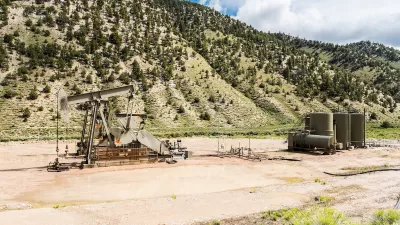A major challenge facing oil companies in the Uinta Basin is how to transport the crude to market. Alignments have been winnowed and the mode appears to be selected - rail. Total cost: $2 billion to extract $30 billion worth of oil and gas reserves.
Shale oil is associated with fracking. Mining oil shale, on the other hand, some may recall, was an expensive project undertaken by President Jimmy Carter that ended in failure. He may have been 30 years ahead of his time. Oil sands, also called tar sands, are mined in Alberta, Canada and may be transported to Gulf area refineries via the controversial Keystone XL Pipeline pending a decision by President Obama.
An oil shale project in the environmental review process is located in Utah's Uinta Basin. "After studying 26 possible routes for a rail line to transport crude oil from the Uinta Basin, the Utah Department of Transportation (UDOT) revealed Friday (June 13) that only one is feasible," writes Lee Davidson about the Uinta Basin Energy and Transportation Study.
That is a 100-mile route southwest to Price would require a 10-mile tunnel through mountains. [See map inset.] It could connect with national rail lines near Price, and take oil to Wasatch Front refineries or anywhere else in the nation to expand Utah energy markets.
Energy development would be lucrative for the state, according to the study results.
The study concluded that there is over $30 billion worth of energy development potential in the Basin. If this potential is realized, it could generate $10 billion of economic revenue and 27,000 jobs statewide over the next 30 years.
However, transport costs will be considerable, explained John Thomas, UDOT project manager for the Uinta Basin rail environmental impact statement (EIS) process. "National averages predict a construction cost of $10 million per mile for the main line, plus $100 million a mile for the tunnel — for a rough estimate of $2 billion overall."
According to a phone call with state Sen. Kevin Van Tassell, chairman of the Senate Transportation and Public Utilities and Technology Committee, a public-private type of partnership would likely finance the transport project.
Last August, Davidson's colleague, Brian Maffly, wrote about groundwater impacts described in the permitting process:
The proposed permit, which puts Utah a step closer to seeing its vast shale deposits mined on an industrial scale for the first time, would excuse Red Leaf Resources from full-scale groundwater monitoring because the company's process doesn't use water, the spent ore is dry and not much groundwater moves through the project area — a finding environmentalists dispute.
The project is not without opposition, as we noted in January.
Gaylen Webb wrote about the Springs Oil Sands project in the Uinta Basin for Utah Business in November, 2012. Earlier, the Utah Water Quality Board approved the first ever tar sands mine on U.S. soil.
FULL STORY: Wells to rails: Utah may build $2 billion line to ship oil

Alabama: Trump Terminates Settlements for Black Communities Harmed By Raw Sewage
Trump deemed the landmark civil rights agreement “illegal DEI and environmental justice policy.”

Study: Maui’s Plan to Convert Vacation Rentals to Long-Term Housing Could Cause Nearly $1 Billion Economic Loss
The plan would reduce visitor accommodation by 25% resulting in 1,900 jobs lost.

Why Should We Subsidize Public Transportation?
Many public transit agencies face financial stress due to rising costs, declining fare revenue, and declining subsidies. Transit advocates must provide a strong business case for increasing public transit funding.

Paris Bike Boom Leads to Steep Drop in Air Pollution
The French city’s air quality has improved dramatically in the past 20 years, coinciding with a growth in cycling.

Why Housing Costs More to Build in California Than in Texas
Hard costs like labor and materials combined with ‘soft’ costs such as permitting make building in the San Francisco Bay Area almost three times as costly as in Texas cities.

San Diego County Sees a Rise in Urban Coyotes
San Diego County experiences a rise in urban coyotes, as sightings become prevalent throughout its urban neighbourhoods and surrounding areas.
Urban Design for Planners 1: Software Tools
This six-course series explores essential urban design concepts using open source software and equips planners with the tools they need to participate fully in the urban design process.
Planning for Universal Design
Learn the tools for implementing Universal Design in planning regulations.
Smith Gee Studio
Alamo Area Metropolitan Planning Organization
City of Santa Clarita
Institute for Housing and Urban Development Studies (IHS)
City of Grandview
Harvard GSD Executive Education
Toledo-Lucas County Plan Commissions
Salt Lake City
NYU Wagner Graduate School of Public Service



























